The following information on modern Mauser rifles from 1898 through 1944 and the Kar. 98k comes from Chapter 22 of Mauser Rifles and Pistols by W. H. B. Smith. Mauser Rifles and Pistols is also available to purchase in print.
All German service rifles manufactured since 1898 and all genuine Mauser sporting high power rifles manufactured since 1904 are mechanically practically identical.
Types from 1924 on have improved gas flanges. Sights and stocks are improved. Barrels are shorter. However, basic design is the same.
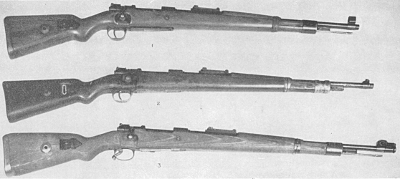
Some varieties of the sporting Mausers were made with set triggers, but otherwise, are mechanically identical with the army type.
The receivers are specially heat treated in all models and in peace time were tested to a chamber pressure of 100,000 pounds per square inch, or practically double the maximum pressure produced in standard army rifles of German or United States design.

Headspace and Gas Escape
Headspace on genuine Mausers is always held to very close tolerances. The cartridge case head protrudes about 2.8 mm past the face of the chamber into the lug well when seated with the action open. The barrel and the recessed face of the bolt surround the cartridge completely on all sides except at the extractor cut, thereby reducing the danger of blown cartridge case heads to an absolute minimum.
A ring shaped groove machined into the receiver between the chamber and the locking lug, is provided to receive the cylindrical bolt head to make a particularly close fit. Any amount of gas which might eventually get through this opening past the bolt head is allowed to escape through openings in the bolt which prevents the flame from spurting to the rear and injuring the shooter.
Two gas vents in the front part of the Mauser bolt permit the safe escape of gas in the event of a blown or punctured primer. The vents are in front of the firing pin plates which prevent the gases from reaching the spring. They are lateral slits 10 x 5 mm (.39 x .195 inch). These are comparatively large, and are so designed intentionally to permit immediate diffusion of any escaping gas.
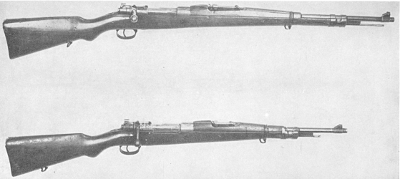
Firing Pin Design
Another feature of Mauser design is the one-piece firing pin of very heavy weight. The firing pin has a safety in the form of a band for the spring to rest upon, having two flanges diametrically opposed. When the bolt is locked these flanges fit into corresponding grooves on the inside of the bolt. When the lock is opened, however, or only partly opened, the position of the groove prevents the firing pin from snapping forward of its own accord under any circumstances.
The Mauser bolt plug (called “bolt sleeve” on our Springfield) is made oversized so that a projecting rim on the forward part, covers the rear end of the bolt as a positive stop against any rearward flow of gas. This is commonly called a “gas flange.”
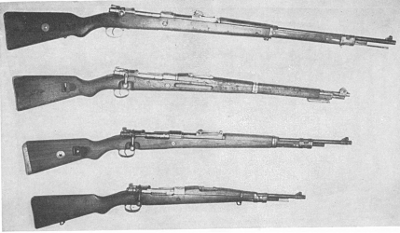
Magazine
The magazine and triggerguard are made in one piece. The magazine base is so constructed that it may be released on its hinge from below by pressure on the button in front of the triggerguard. This permits unloading the magazine without operating the bolt and functioning the cartridges through the mechanism. This magazine is closed at the bottom with a plate flush with the stock. The capacity is five cartridges, held in double staggered rows.

Bolt Characteristics
The bolts on these rifles differ from those of earlier Mausers, and of most other bolts, in that a third (or safety) lug is placed on the rear section of the bolt, and that a travel-guide rib is also provided.
The bolt itself is of very simple and strong construction. It is one piece with the bolt head which is not removable. Two locking lugs are placed opposite each other at the front end to lock into corresponding recesses in the receiver. The third or safety lug at the rear of the bolt engages in a recess in the cylindrical part of the rear end of the receiver. In the unlikely event that both the front lugs should let go, this rear lug is designed to hold the bolt.
The bolt handle or lever may stand out straight at right angles as in the early military patterns, may be turned down as in the later Kar. models, or may be specially shaped to lie flat against the stock as in some of the sporting types.
A cam shaped recess at the rear end of the bolt receives the stud of the cocking-piece. Thus when the bolt handle is turned up, the camming action withdraws the striker from the face of the bolt, since the cocking piece is so shaped that it cannot turn and hence is forced straight back together with the striker. At the opposite side there is a small notch to receive the tooth of the safety bolt. A small rib on the bolt body acts as a guide in withdrawing the bolt. When the bolt is closed, this rib lies below and supports the extractor. The face of the bolt is specially recessed to take the base of the rimless cartridge which it encloses entirely except at the extractor point.

The one-piece striker has a short point, and a collar against which the mainspring bears for cocking. The rear of the striker has three interrupted grooves to connect it with the cocking piece. The rear portion of the pin is flattened on two opposite sides to keep it from revolving inside the bolt plug.
The mainspring when not compressed measures about 5 inches long, and is composed of 28 to 31 coils of .06 inch diameter wire, the number of coils varying with the pattern of the rifle.
Interrupted lugs on the cocking piece permit it to be connected to the striker pin by giving it a quarter turn. Note that it is impossible to join these incorrectly, since the rear groove on the striker and a corresponding bearing in the cocking piece, are broader than the two front ones.

A projection on the under side of the cocking piece travels in a groove cut for it in the tongue in the receiver. When the bolt handle is turned down, this projection is engaged with the sear nose so that the bolt handle turning down the inclined face of the receiver bridge pushes back the stud to compress the mainspring. The bolt lugs passing along the cam slots to their locking recesses add to the mainspring compression thrust. The forward top surface of the stud is chamfered to mate with the sloping surface at the end of the bolt; thus on turning up the bolt, the cam surface forces the stud back to give initial compression to the spring and also withdraw the point of the striker from the fired primer.
The bolt plug (sleeve) screws loosely into the rear end of the bolt by means of a reinforced thread. It closes the opening through which the striker is inserted when assembling, and also serves as a seat for the mainspring. The bolt plug does not turn when the bolt is operated as the cocking stud works in its slot. The front part of this bolt plug is semicircular in shape, providing a flange which acts as a shield to protect the user against accidental back blast in case of a blown cartridge case or primer.

On the left side of the bolt plug there is a pin catch which when in position engages with the bolt and holds the bolt plug and bolt securely locked against accidental unscrewing during opening or closing movements. A cylindrical hole is drilled in the top of the bolt plug to receive the bolt of the thumb safety which is positioned on the assembled firing pin.
The safety bolt itself consists of a thumb piece and a spindle which works in a hole in the bolt plug. When the thumb piece is turned to vertical position, and the bolt is closed, the flange on the safety bolt is thrust up in front of the top of the cocking-piece, forcing it back a little and withdrawing the stud from contact with the sear. This positively prevents release of the striker. When the thumbpiece is turned over to the right, the cocking-piece is still locked; but at the end of the stem where it is not cut away it enters into a slot on the end of the bolt, locking the bolt and bolt plug together, to prevent the bolt from being revolved.
The safety bolt is held in the two safety positions by the top of the cocking-piece bearing on shallow depressions on a flange in the safety bolt itself.

The Extractor
The extractor is a wide, long H-spring, terminating in a claw. The front of the claw is chamfered to enable it to ride over the base of the cartridge, as the cartridge is chambered, thereby enabling the hook to engage in the groove at the base of the cartridge, and support it solidly against the bolt head ready for extraction. An undercut groove on the extractor engages on dovetail projections on the spring band which revolves in a groove on the bolt. A projection working in a groove at the bolt head permits the pull of the bolt to be transmitted to the extractor.
When the bolt is drawn back the right hand lug lies under the extractor in a recess provided for it. This feature of a non-revolving extractor is particularly valuable because it prevents friction between the extractor and the face of the discharged cartridge, and also because it does away with the necessity of cutting away the rear end of the barrel to afford clearance for the extractor end.
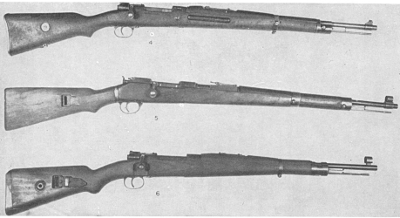
The Receiver
The receiver, to which the barrel is screwed, is grooved on either side of the boltway to provide for the working of the bolt lugs and extractor. The right hand groove is partly cutaway to permit ejection of the case to the right. The twin recesses for the locking lugs are at the forward end of the receiver and are connected, of course, with the travel grooves.
The rear section of the receiver through which the bolt must travel forms a complete cylinder (or bridge) in whose forward end the clip guides are machined; while to the rear of this it lengthens into a tang which is recessed to permit the cocking stud to move over it. This tang is bored and threaded to receive the rear action screw which aids in holding the action, triggerguard and stock together. An opening is provided in the tang to permit the sear tooth to project. A cross groove is cut directly behind the magazine way to receive the third safety locking lug.
The bottom of the receiver is cutaway to provide for the magazine, which is one piece with the triggerguard and which is fastened to receiver and stock by screws.
A ribbon spring secured to the magazine bottom plate and the underside of the follower serves to thrust the follower up and support the cartridges above it. The follower has a raised rib on its left side which elevates the cartridge column above it almost to the level of the right hand column, and thereby serves to bring a cartridge up from each side alternately to be held by the overhanging magazine lips until stripped forward by the bolt for chambering. A small stud to the rear of the magazine well serves to secure the magazine bottom plate. (In some sporting models this takes the form of a swinging lever below the bottom plate). This stud can be depressed by the point of a bullet and the plate can then be slid backwards and removed, bringing the spring and follower with it.
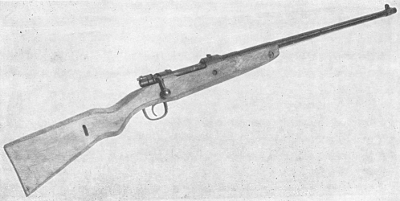
Magazine Design
Special box magazines holding additional numbers of cartridges up to 20, were provided for military purposes, to be inserted in place of the bottom plate of the standard magazine, but the standard holds 5.
The magazine may be loaded by individual insertion of cartridges, each one being pushed down into the magazine, or may be loaded by stripping in five cartridges directly from the clip. The clip itself, is the familiar thin sheet of steel, having edges turned over to engage in the grooves in the cartridge cases, while a spring of wavy ribbon steel, fastened by two small tangs to the inside of the clip, holds the cartridge heads firmly.
Note that while the cartridge clip may be pulled out of the receiver guide, after the cartridges have been stripped into the magazine, this is not necessary. Thrusting the bolt forward, will automatically eject it from the action.
Trigger Mechanism
The trigger mechanism is the standard double pull. The sear projects into the groove in the tang provided for it, and is part of a bar pivoted near its front end to the receiver. The sear is actuated by a spiral spring let into it, whose other end bears against the receiver. The bar section of this seat has a vertical slot in which the trigger is pivoted.
When the trigger is pressed, the front of the two projections on the upper surface of its arm, presses against the receiver, thereby lowering the sear, and giving a sliding movement. At this point, the leverage now that the slack has been taken up, is transferred to the rearmost projection. At this point, a slight check is noted, and continued pressure on the trigger releases the sear from the cocking-piece stud, permitting the mainspring to drive the striker forward to fire the cartridge.
Note that no half-cock system is included in this design. The striker is cocked usually by opening and reclosing the bolt.
To prevent accidental withdrawal of the bolt from the receiver, a stop hinged on the left side of the body is provided with a tooth which projects through a slot into the groove for the left lug of the bolt. This lever, which is pivoted on a pin, is kept pressed against the receiver by a small flat spring let into it. As the bolt is pulled to the rear, its left lug comes in contact with this tooth, preventing any rearward movement beyond that point. Pulling out on the bolt stop pivots it to withdraw the tooth from the path of the lug, which permits withdrawal of the bolt from the receiver.
Ejector Mechanism
The Mauser ejector pivots on the same pin as the bolt stop of which it forms a part. It is triangular in shape, and is flat. It is actuated by a spring inside the bolt stop lever. There is a slot cut in the left locking lug and in the face of the bolt head for passage of the ejector; and when the bolt is withdrawn, the ejector springs into this slot. The base of the cartridge being gripped by the extractor strikes against the ejector. Since the extractor continues to draw the right side of the cartridge, and the ejector pressure is on the left, the cartridge or cartridge case is swung around and thrown out of the grip of the extractor and out of the action. The stock is in one piece, and on all models after 1904, is provided with a half pistol grip. The fore-end is attached to the barrel on the military model by two bands. A hand guard is provided which is secured to the lower band. The butt plates are of steel in most military types. In sporting types, they may be hard rubber, or cushioned. A half length cleaning rod is provided, which is threaded to permit being joined to another rod.
